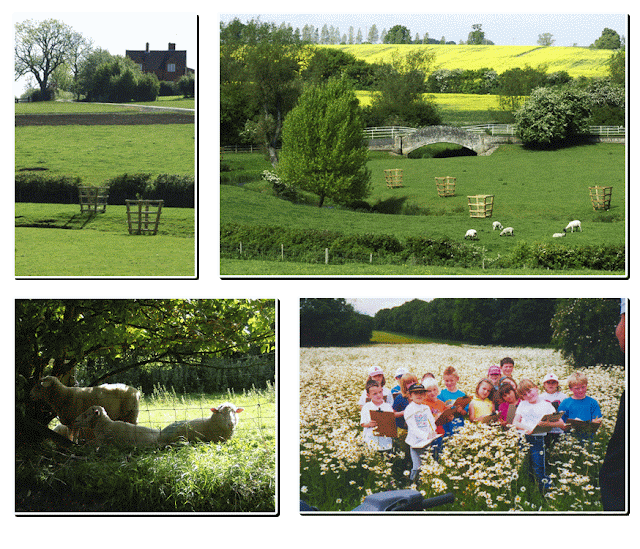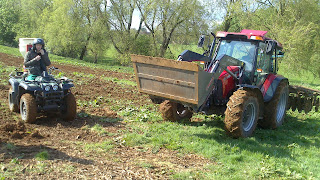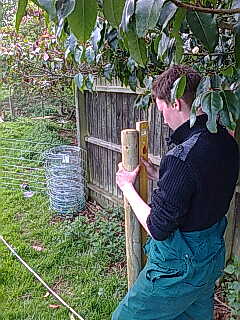Thursday, 30 May 2013
Tuesday, 28 May 2013
Student Research Leads the Way!
Our higher education students are now nearing completion of their studies for this year and many of the students are busy collecting data for their undergraduate dissertations. This is a terrific challenge for students who are faced with researching, planning, carrying out and then writing up their work in a 10,000 word document! Over the years the work has been so well received it has led to conference presentations and even publications and articles to be published to the wider scientific community.
This year the range of projects being undertaken is very diverse and reflects some very under-researched areas within agriculture and conservation. For the BSc Land Management course, here is a list of who is doing what so you can see what we mean:
Agriculture & Farming
Conservation and Ecology
This year the range of projects being undertaken is very diverse and reflects some very under-researched areas within agriculture and conservation. For the BSc Land Management course, here is a list of who is doing what so you can see what we mean:
Agriculture & Farming
- Affect of lamb breed on lambing success in England and Wales - Aileen
- Evaluation of one pass soil seed rape establishment using different drill types at Lamport Hall - Guy
- Use of bioelectrical impedance analysis to predict carcass traits in live lambs - Prosper
- Effectiveness of biofertilisers on the growth of winter wheat - Tom
- Use of e-technology in calculating the green area index for winter wheat - Nick
- Use of e-techonology in calculating the green area index of oil seed rape - Steve
Conservation and Ecology
- Open mosaic habitats and their associated Coleopteran assemblages - Carole
- A study of non-target wildlife species feeding from gamebird hoppers on intensively managed shoots - Dan
- RFID method for the spatial determination and tracking of harvest mice in the wild - David
- Impact of ride management on native butterfly assemblages in ancient woodlands - Jamie
- Effectivness of deer deterrants in influencing spatial distributions of free roaming deer in parkland and woodland - Jarvis
- Habitat preferences of marsh tits and blue tits at Monks Wood National Nature Reserve, Cambs - Lewis
- Ecological impact of muntjac deer on ancient woodlands and potential ecosystem services - Luke
Tuesday, 21 May 2013
The Skys Above Moulton are Filled with Birds of Prey!
Countryside Management, Animal Welfare and Agriculture
students were wowed by a birds of prey demonstration from Icarus Falconry of
Northamptonshire on Monday 20th May. The demonstration covered
a wide range of topics including the care and training required to keep and
raise birds of prey along with the importance of the conservation of these
birds of prey. The birds that were brought to the demonstration and flown
on the day included a young Bateleur Eagle, a Black Kite, a Harris Hawk and a
Barn Own.
National Agricultural Colleges Clay Shooting Championship
A team comprising Countryside
Management and Agriculture students along with Gamekeeping lecturer Bob Farmer
attended the 2013 National Agricultural Colleges Clay Shooting Championships at
Warwickshire College last Saturday. Students, David Ferriman and Reece Brown
tied for 2nd place with a team from Harper Adams University in the
Flush Competition resulting in a bit of cash coming their way! The team also
came 8th in the Championship.

Friday, 17 May 2013
Countryside Students Bridge the Gap.....
A small group of countryside
students used the skills they have gained over the last two years to construct
a small bridge using just the timber they have cut from the woods. Rob, Dave
and Tom took a while to get warmed up but once they got going there was no
stopping them! As Tom busily felled suitable trees, Rob and
Dave were hammering away fixing the bridge together. By the end of the session the group
had constructed a simple yet affective wooden bridge.
Farming for Wildlife at Rectory Farm
Yesterday, Higher Education students were hosted by farmer George Eaton at Rectory Farm in Buckinghamshire. George farms an idyllic small farm in a traditional manner, but the difference is he has fully embraced environmental grant aid to farm for wildlife. Working with Natural England and Kings Seeds, George was able to explain how his commercial farming ventures (which include producing beef for waitrose) achieve a balance with managing the natural environment for conservation.
Alongside expanses of wheat and grassland leys, George manages two county wildlife sites (both traditional wildflowet meadows) and a stretch of river where water vole and otter both occur. He obtains some funding through the environmental stewardship suite of grants and students were able to see the diverse range of options employed on the farm. You can find out more about Rectory Farm here: http://www.rectory-farm.org.uk.
Alongside expanses of wheat and grassland leys, George manages two county wildlife sites (both traditional wildflowet meadows) and a stretch of river where water vole and otter both occur. He obtains some funding through the environmental stewardship suite of grants and students were able to see the diverse range of options employed on the farm. You can find out more about Rectory Farm here: http://www.rectory-farm.org.uk.
Thursday, 16 May 2013
Cover Crop Gets Laid....
Countryside management students
have been preparing the colleges cover crop, having completed their NPTC ATV
& Tractor driving certificates as part of their course they had a chance to
put their qualifications into practice. They used the colleges new Case tractor
to disc the soil to break down the clods to prepare a fine seed bed. They then drove the quad bike and grain
spinner to broadcast the mixture of seeds which would form the bulk of cover
for the college game birds.
The cover crop they have sown contains maize, red and white
millet, sunflowers, kale, buckwheat and forage rape. This will produce a cover
crop that will provide additional feed, cover and shelter for the pheasants and
partridges found on the college’s 430 hectare estate.
Tuesday, 14 May 2013
Countryside Students turn up the heat....
Countryside Management students
Angus, Jo, Sam and Elly try the team approach to making fire by friction. As
part of an enrichment activity linked to their course students have learned how
to make fire by friction using the bow drill method. They spent the morning
selecting appropriate material such as elder and willow to make the drill and
hearth of their fire kits and then whittled a bow from green wood before
putting everything together to try and make fire.
Friday, 10 May 2013
Countryside Students Stock Fence....
Countryside
Students continued to help out on the college estate. This week saw students
putting in gates and constructing stock proof fencing to keep the colleges 1000
North Country Mules out of the neighbouring estates.
Greg,
Dan and Ryan can be seen driving the posts in and then checking they are straight with a spirit
level. There are plenty of opportunities for the countryside students to gain real
landbased practical experience on the colleges 450 hectares.
Pleasant Pheasant Egg Hunt...
Countryside
Management students recently successfully completed a project rearing Japanese
Quail but keen for more experience they have now started to prepare a batch of
Pheasant eggs for the incubator.
In
January the students caught wild pheasants on the college estate just as
keepers all around the country would have been doing in preparation for rearing
the next season’s pheasants. These pheasants were then housed in pens built by
the students and fed a high protein diet to ensure they produce good quality
fertile eggs. The birds have been laying since the beginning of April and about
80 eggs have been collected over the last ten days. These eggs have been washed
and sterilised and are now in the incubator and will hatch in 24 days’ time.
You can see Greg and Dan carefully putting the precious eggs through this
process in the pictures below.
Practical Work at Bush Walk Woods SSSI Proves a Success for Wildlife
From an agreement with the Ginpat Charitable Trust and Natural England (NE), Higher and Further Countryside Management students have been undertaking practical and survey work at Bush Walk Woods SSSI - an 8 acre section of a much larger ancient woodland.
Designated as a Site of Special Scientific Interest by virtue of the unusual woodland plants found at the site, staff agreed a management plan with the owners and NE which is methodically being implemented. With spring now finally here, the woodland thinning and ride clearance work has resulted in a profusion of common spotted orchids (pictured) and regrowth of the hazel understorey. Indeed, selective thinning rather than sporadic coppicing is the key to reducing the main ecological limiting factor at this site - lack of light.
Dormouse nest boxes have also been set out in the wood in the hope of finding some of these rare woodland critters - check back to the blog to see if any found when the boxes are checked in June!
Thursday, 9 May 2013
Countyside Students Continue to Build Bridges!!
This week the second group of
countryside students took on the bridge building task. Again the group took to
the challenge with energy and enthusiasm expected of those planning practical careers
in the great outdoors. Angus took on the role as team leader doing a fine job
organising the rest of the team and ensuring everyone knew what they were
doing. Elly and Joe didn’t stop despite the onset of blisters while Phil and Sam
made rapid progress in dismantling the handrails.
Wednesday, 8 May 2013
Countryside Students Tractor Driving Skills Continue to Improve....
The countryside Students have been back out in the tractors this week. The group practised their driving with trailers attached and demonstrated how to tip rubble safely. Abbey and Brady can be seen chugging across the yard with Brady providing expert advice to an already very compitent Abbey!
Tuesday, 7 May 2013
Deer Management at Bush Walk Woods
Extended
Diploma Countryside Management students have recently prepared deer management
plans for a local woodland. They have carried out regular surveys of the wood
including the use of ‘trail cam’s’ (remote cameras which can be positioned in the
woods and will record movement of wildlife) to determine which deer species are
present and their approximate numbers.
They have found
that there is a healthy population of Reeves Muntjac present in the woods and
have recently submitted plans which would ensure that the deer population does
not negatively impact on the sensitive ground flora and planned coppice work in
the woodland.
Otter Holt Completion
The second phase of the otter holt build is now complete,
and all that is left is to pin the structure down in-case the flood waters
rise. The hexagonal, chambered structure was roofed with brash, waste timber
and turf to create a non-intrusive holt for any resident otters – Lois, David
and Dan are pictured standing outside the holt. A camera-trap was placed near
the entrance so any subsequent use can be monitored – check back to the blog to
see if the otter’s occupy their fancy new home!
In addition, students carried
out some water quality testing by ‘kick-sampling’ a gravel riffle and
identifying macro-invertebrates found (pictured). Some species are more
tolerant of pollution than others, but thankfully clean water indicators
including stoneflies were present.
Friday, 3 May 2013
Hunt for Rare Amphibian Proves ‘Great’ Experience
An intrepid team of HE students including Martin (pictured),
Heather, Helen, Nat, Joe, Mark, Kat and Liz checked the live capture traps on
the ponds on the eastern margins this morning which yielded a fantastic result
– live specimens of the rare and protected Great Crested Newt. Pictures were
taken of the ornate belly markings to allow subsequent identification of
individuals specimens – in this case a mature male. Unusually long lived, these
fascinating creatures are a welcome addition to the biodiversity of the farm.
Wednesday, 1 May 2013
Countryside students survey the pitfalls of hedgerow biodiversity
Countryside management students
continue to look for signs of life in the college hedgerows. Having identified
the value of the college hedgerows in previous weeks, the group set out to find
what insects the farm hedgerows were supporting. The students set five pitfall
traps at five very different hedgerows so they could compare the results and
calculate the value of each of the hedgerows.
Tom managed to dig up part of an
old chain-harrow as he set his pitfall trap which led to a group discussion on
what they would do if they dug up an historical artefact such as a pot of roman
coins. While no decision was made on what the group would do if they did make
such a discovery it was agreed that an unexploded second world war bomb was the
item they would least want to dig up…..
High River Levels Refuse to ‘Holt’ Otter Build
BSc Land Management students had an opportunity to do
something a little different this week – to build a home (or holt) for
Leicesteshire’s threatened otters. Staff member James has built several of
these over the years and has the hexagonal, chambered and thatched design down
to a fine art!
The mystery location of the holt was a river west of Corby
that has received funding from the Environment Agency (EA) to restore the river
system. As well as new fencing, cattle drinkers, flow deflectors and bank stabilisation
areas an otter holt was also on the list, and this is where our group of
students working with the EA and Ecology Link Ltd led by Lewis, David, Jarvis
and Amber bravely stepped up.
Of course, otters do not dig their own burrows and are hard
pushed to find suitable areas to hide when river corridors have been
channelised and improved so much. So what better way to help them occupy this
area than by building them their own ‘des-res’?! As you can see from the
pictures the holt is half finished, so check back to the blog next week to see
the finished masterpiece! Trailcam’s will also be set up to monitor occupancy.
Subscribe to:
Comments (Atom)





















.jpg)


























